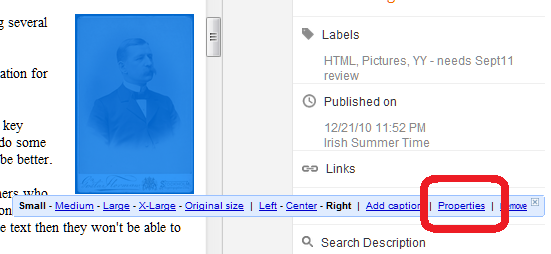Your RSS feed and the Publish button
I've previously described why RSS is important for bloggers who care about building an audience.
But it's also important to realise that:
- Some of your RSS subscribers only see the first version of each post that you publish, not the most recently edited one.
- Even if you delete a post from your blog shortly after publishing it, the published version is still in your RSS feed and will be seen by people who read it.
(I've heard that some feed-aggregator / reader tools do delete items, however some eg Google Reader, don't.)
Personally, I took a long time to understand the consequences of this: When I started blogging, I Published early-and-often while I was writing each post, so I could see what it "felt" like. (The Preview button, because it shows you the "look" but not the latest content, and editing the content was important to me.) This meant that subscribers saw very early, drafty versions of my posts, so many of them decided to unsubscribe pretty quickly.
Even after I understood, I still occasionally hit Publish by accident. And my writing wasn't good, because I find it hard to proof-read properly in the post-editor.
So far I've found two ways of using Blogger that can address this problem.
Option 1: Turn the blog-feed off, except when you publish the final version
Posts are only sent out in your blog's feed if the feed is turned on. So every time you want to work on a post:- Turn the feed off (Settings > Site Feed > Allow Blog Feeds = None)
- Work on your post, Publishing it as you like
- Save the Post as Draft (so it's status is back to draft again)
- Turn the feed on (Settings > Site Feed > Allow Blog Feeds = anything except None)
This is particularly good approach if you have a lot of email subscribers via Feedburner - because that tool is currently (Dec 2010) sending out an update every time a post is published or updated, instead of just for every "new" publication (ie one that changes the post-status from Draft to Published).
However it's very manual, and there's always a risk that you might forget to turn the feed on or off at the right moment.
Option 2: Prepare posts in a separate blog
This is my preferred approach, and now there are at least three different "blogs" for each blog I that run:
- The blog (what IT professionals call "production")
- A documentation blog, where I keep my notes about how it's put together
- A pre-publication blog, when I keep posts that are being worked on.
- Private (Settings > Permissions > Blog readers = Only Blog Authors)
- Not listed (Settings > Basic > Add your blog to our listings = No)
- Not indexed (Settings > Basic > Let search engines find your blog = No)
- Not listed on my Blogger Profile (Dashboard > Edit Blogger Profile > Select blogs to display)
When I'm preparing a post, I work on it in the "pre-production" blog, and can Publish it as many times as I like. Then when it's complete, I simply copy the post from the pre-prod blog to the real one, and publish it once.
A big benefit is that if I get an idea about a potential post, I can just go to the pre-publication blog and make a very quick note about it: the writing and research quality doesn't matter, because I'm the only person who sees it.
The one thing I need to do is to always check and re-check the blog I'm about to post in, every time I hit "Publish": the day after I first released this post was the first time in ages that I accidentally published a draft post to this blog (subscribers will have seen it come through the feel) .... very embarrassing indeed!
Have you found other ways to avoid problems like this?
I'd love to hear about what works for you.
Related Articles:
Copying a post from one blog to another.
Why RSS is important for bloggers who care about building an audience
Using Feedburner to manage email subscribers
Restricting who can see your blog
Understanding Google Accounts
Planning changes to your blog in private - using a test blog




